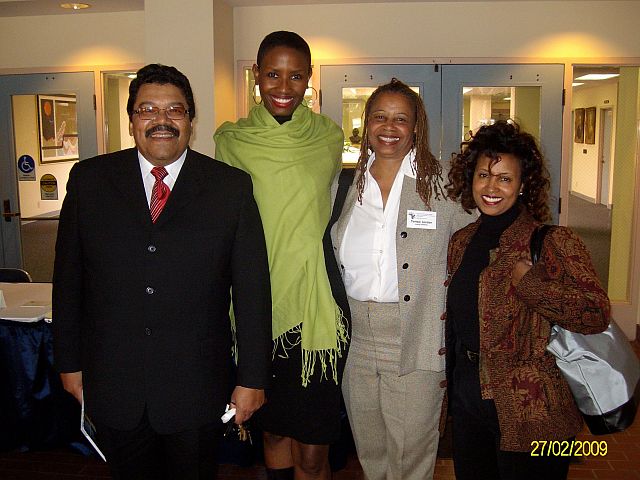 When the going gets tough and the tough gets going, where do most small and medium size U.S./Western businesses look to make money? If you guessed Africa,give yourself a pat on the back because you are right!
When the going gets tough and the tough gets going, where do most small and medium size U.S./Western businesses look to make money? If you guessed Africa,give yourself a pat on the back because you are right!
“The Trade and Investment with the AGOA Countries in Africa” Conference produced by the Monterey Bay International Trade Association [MBITA] and held, late last month, at the Monterey Institute of International Studies was all about how U.S. based small and medium size businesses could boost their profit margins by doing business in Africa.
When there is a mention of U.S. businesses doing business in Africa, typically most think non-minority owned businesses and big corporations. Let’s be clear. Doing business in Africa extends to African and other minority owned U.S. businesses. The tools and resources shared below are for YOU and you should take advantage of it.
Throughout the conference, the message was precise and clear. “You need to be doing business in Africa because Africa is the place to be.” To that effect, the conference kicked off with James Kirru, Commercial Attache at the Embassy of Kenya in Washington D.C.
Kirru focused on Kenya and why U.S. businesses should invest in Kenya. Did you know, for example, that Kenya: 1) is a land of opportunities; 2) has huge resources and raw materials; 3) as of 2007, its GDP was $27 billion; 4) has hosted UNEP and Habitat; 4) houses the African headquarters for USA and Europe’s media multinationals and organizations such as CNN, BBC, IMF and the World Bank?
In addition, did you know Kenya has the highest number of professionals in Africa; or that as of 2006 over 1.6 million tourists visited its shores? Kirru highlighted all of these and spoke about Kenya’s Vision 2030. A vision focused on rebuilding and attracting foreign direct investments in tourism, agriculture, wholesale and retail sectors and improving its economic, social and political landscape so U.S. investors, for example, can feel confident doing business in Kenya.
Naturally for those looking to do business in Africa, there are many myths to debunk, realities [corruption, bribery, poor infrastructure etc.] to contend with and resources to be aware of. The rest of the conference focused on addressing these.
Michael Blakely, a Principal Associate at Nathan Associates Inc. with a niche on Enterprise and Industry Development, presented right after Kirru. He explained the African Growth and Opportunity Act [AGOA] and identified where the opportunities exist. See Ladybrille’s AGOA interview with the U.S. Trade Office.
For instance, Blakely identified sourcing opportunities in apparel, footwear and leather products that take advantage of AGOA. Specific to apparel, for example, Blakely explained prior to AGOA duty fees were as high as 20-30%. After AGOA, it is now duty free. Blakely also pointed a rising trend where U.S. brands are shifting their production to Africa, for example, Hallmark and Food Emporium New York. In the final analysis, he urged U.S. businesses to look at Africa because under AGOA, it makes no sense not to. He concluded his presentation highlighting opportunities for U.S. businesses in Africa for: 1) African manufacturers to manufacture for the U.S. market of respective U.S. businesses; 2) competitive U.S. import sourcing; 3) exports to manufacturers serving the U.S. Market in Africa [i.e. inputs, packaging etc.]; and 4) investments.
Following Blakely was a presentation by Joseph Nganga, CEO of Africa Energy Renewables who is Kenyan. Nganga explained that Kenya’s current peak electricity demand is at 1151MW and a projected growth of 7% is anticipated so that it will reach 3011 by 2018. Consistent with Kirru’s presentation, he explained the Kenyan government is committed to connect 1 million new customers in the next five years. Such commitment extended to a more friendly approach to the private business sector as part of the solution in the generation and distribution of power. Investment opportunities for those interested in energy and renewables include: transformer manufacturing, distribution infrastructure, smart meters, power plan construction including coal, natural gas, wind, solar, biomass, hydro and nuclear.
Where Nganga ended his presentation made a good transition for Mary [Molly] Uzoh Founder/CEO of Learning Right Technologies LLC, who made the case for Africa as a land of opportunities. Speaking on behalf of Bamba Thiam, President of Afrisystems Inc., Uzoh pointed more specifically to opportunities in Africa as a whole in agriculture, health, textiles, pharmaceuticals, water, irrigation, technology, water technology, enery and a whole host of areas.
With the tagline U.S. Investment in Africa = Opportunity for U.S. Business, Dr. Judith Chambers, Agribusiness Advisor, Millennium Challenge Corporation [MCC] and President of Emerging Market Solutions launched into programs the U.S. has to help U.S. businesses looking to invest in a place like Africa. More specifically, the MCC provides funding for MCC “eligible” countries making them good targets for trade, investments and business on the part of American companies.
How do countries become eligible? Countries “must adopt sound, market oriented economic polices that create enabling climates for business, demonstrate good governance and aggressively deal with corruption.” MCC, as it stands, has approved more than $5.5billion for agriculture related investments in 16 countries, African countries included. What was intriguing about Dr. Chambers’ presentation, beyond how MCC’s current investments and funding process, was her revelation of the finding of cures for ailments like arthritis in Africa for the Western market through Africa’s natural plants, among many findings.
Roderick A. Hirsch, Director of Oakland Export Assistance Center for the US Department of Commerce’s, provided more of the logistics on steps you need to take to make doing business in Africa a reality. There is simply no need to reinvent the wheel. According to Hirsch, their [government] agency serves as your eyes and ears on the ground in your desired country to find the right people for you. Further, the organization can organize events and promotions surrounding your product’s entry to Africa. In addition, its involvement in the International Buyer Program allows the organization to help with match making for you and local partners in your desired country in Africa.
The presentation by Michael K.Durney, partner, Ventana Funding Capital Resources; President, Mamperza Industrial, SARL, Benguela, Angola, underscored Hirsch’s presentation and the importance of having an agency like the U.S. Department of Commerce do all the work for you before you step into the African market. Durney shared his experiences doing business for decades in Angola. While there were numerous obstacles along the way, some of which ultimately resulted in closing down his fishing business of decades in Angola, Durney, nevertheless, maintained, Angola is a great place to do business and “offers more opportunity than virtually all other Sub-Saharan countries due to its enormous mineral wealth, natural resources, flavorable economic and governmental climate.”
While there were a few more speakers that touched or appeared to overlap points already made by prior presenters, really rounding off the presentations was Lerato D. Mataboge, Economic Minister for the Embassy of the Republic of South Africa in Washington, D.C. Matagobe spoke a bit more extensively on the fact that since the implementation of AGOA, Africans and their respective countries have not really taken advantage of this trade law that is highly beneficial to them. She cited the lack of diversification and industrialization as two causes of the non-use of AGOA. She stressed that African countries would need to implement trade policies that are compatible with their respective industries, increase competitiveness and create a skilled work force. South Africa [SA], according to Mataboge, was committed to doing so. She highlighted some of the works being done by the SA government and identified opportunities in investments, many of which had already been identified, adding film and media.
To find out more on investing in Africa and the advantages of AGOA, check out the following resources:
Monterey Bay International Trade Association
TradePort.org
GlobalCalifornia.com
Los Angeles Area Chamber of Commerce
California Chamber of Commerce
Agoa.gov
California Trade Partners
Photo: L-R: Jose Juarez, East Bay Center for International Trade Development (CITD); Uduak Oduok, Publisher, Ladybrille; Tenday Jordan, Vice President, Andisa Systems, Inc.; Yalem Lakew, Board Chair, Ethiopian Philantrophic Organization, Inc
Photocredit: Yalem Lakew
Founded in 2007, Ladybrille® Magazine is a California based pioneer digital publication demystifying the image of Africans in the west through contemporary African fashion and celebrating the brilliant woman in business and leadership, with an emphasis on the African woman in the diaspora. Our coverage includes stories on capital, access to markets, expertise, hiring and retention, sales, marketing, and promotions.


